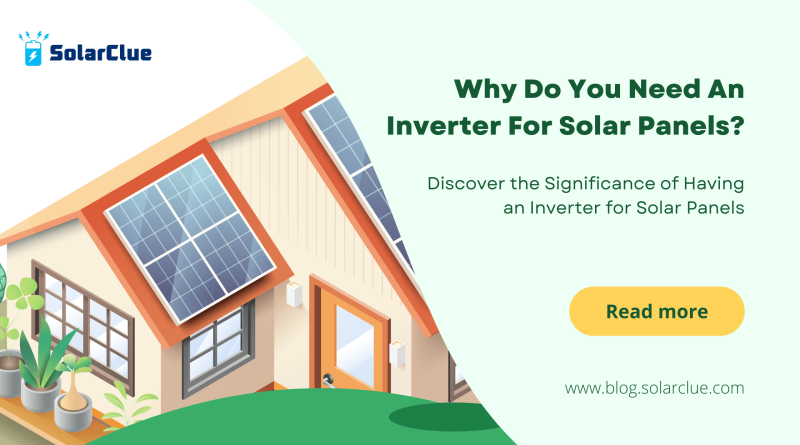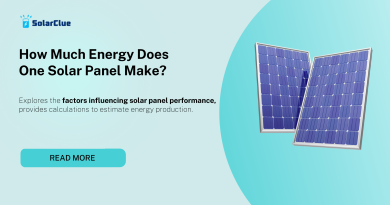Why Do You Need An Inverter For Solar Panels?
Inverters play a crucial role in solar power systems, converting the direct current (DC) electricity generated by solar panels into alternating current (AC) power that can be used by home appliances and fed into the grid. This blog delves into the various aspects of inverters, their types, efficiency, installation, and future trends.
Table of Contents
The Role of Inverters in Solar Energy Conversion
Solar panels generate DC electricity, which cannot be directly used by most household appliances or the electrical grid, both of which operate on AC electricity. Inverters convert this DC electricity into usable AC power, ensuring that the energy produced by solar panels can be efficiently utilized. Inverters also manage the performance of the solar power system, including monitoring, safety shutdowns, and maximum power point tracking (MPPT).
Types of Inverters and Their Applications
String Inverters: These are the most common type of inverters used in residential and commercial solar installations. A single string inverter is connected to a series of solar panels (a string). Advantages include lower cost and simpler installation. However, their performance can be affected by shading, dirt, or mismatched panels, as the entire string’s output can be compromised by a single panel’s underperformance.
Microinverters: These are installed on each individual solar panel, allowing each panel to operate independently. This setup maximizes energy harvest, as the performance of one panel does not affect the others. Microinverters are ideal for installations with shading issues or complex roof layouts. The main disadvantages are higher costs and more complex installation compared to string inverters.
Power Optimizers: These devices are used in conjunction with string inverters to optimize the performance of individual panels. Power optimizers condition the DC electricity before sending it to the string inverter. This setup combines the benefits of both systems by improving performance and flexibility while keeping costs lower than microinverters. However, they still require a central inverter, adding complexity to the system.
Inverter Efficiency and Its Impact on Energy Output
Inverter efficiency refers to how well the inverter converts DC electricity to AC electricity. High-efficiency inverters ensure minimal energy loss during conversion, directly impacting the overall energy output and efficiency of the solar power system. Inverter efficiency ratings typically range from 95% to 99%, with higher efficiency translating to better system performance and greater energy savings over time.
Matching Inverter Size to Solar Panel Capacity
Properly sizing an inverter to match the solar panel capacity is crucial for optimal system performance. Undersized inverters may limit the system’s output, while oversized inverters can lead to unnecessary costs. The inverter’s capacity should align with the expected power output of the solar panels, considering factors such as geographic location, panel orientation, and shading.
Inverter Installation and Maintenance
Inverter installation should be carried out by a qualified professional to ensure safety and compliance with local regulations. Regular maintenance, including monitoring system performance and checking for software updates, is essential for ensuring long-term efficiency and reliability. Periodic inspections can help identify and address potential issues before they impact the system’s performance.
Troubleshooting Common Inverter Issues
Common inverter issues include connectivity problems, error codes, and reduced efficiency. Regularly checking the inverter display for error messages and consulting the user manual for troubleshooting steps can resolve many issues. If problems persist, contacting the installer or manufacturer for technical support is advisable.
The Future of Inverter Technology and Its Impact on Solar Power Systems
Advancements in inverter technology, such as smart inverters and integrated energy storage solutions, are shaping the future of solar power systems. Smart inverters offer enhanced grid support, remote monitoring, and better integration with energy storage systems. These innovations are expected to improve overall system efficiency, reliability, and grid stability, making solar power an even more attractive option for energy generation.
Inverter Safety and Regulations
Inverter safety is paramount, as they handle high voltages and currents. Compliance with safety standards and regulations, such as those set by the Underwriters Laboratories (UL) and the International Electrotechnical Commission (IEC), ensures that inverters operate safely and effectively. Proper installation, regular maintenance, and adherence to manufacturer guidelines are essential for maintaining safety and performance.
Types of Inverters and Their Characteristics
| Type of Inverter | Description | Advantages | Disadvantages |
|---|---|---|---|
| String Inverters | Connects to a series of solar panels (a string) | Lower cost, simpler installation | Performance affected by shading or mismatched panels |
| Microinverters | Installed on each individual solar panel | Maximizes energy harvest, ideal for shading issues | Higher costs, more complex installation |
| Power Optimizers | Used with string inverters to optimize panel performance | Improves performance, cost-effective | Requires central inverter, adds complexity |
Conclusion
Here at SolarClue®, we offer a smart, practical, and “beautiful” solution. You will be answered for all the questions related to Solar.
We provide all kinds of brands that are the Best Solar panels in India.
If you are the one who is planning for the solar power system. Don’t hesitate to contact our team!
Looking forward to empowering you with solar energy, just like hundreds of our other clients!
FAQs
1. What is the main function of an inverter in a solar power system?
The primary function of an inverter is to convert the direct current (DC) electricity generated by solar panels into alternating current (AC) electricity, which can be used by household appliances and fed into the electrical grid.
2. What are the different types of inverters used in solar power systems?
The main types of inverters are string inverters, microinverters, and power optimizers. Each type has its own advantages and disadvantages, depending on the specific application and installation conditions.
3. How does inverter efficiency impact the overall performance of a solar power system?
Inverter efficiency affects how much DC electricity is converted into usable AC electricity. High-efficiency inverters minimize energy loss during conversion, leading to better system performance and greater energy savings.
4. Why is it important to match the inverter size to the solar panel capacity?
Properly sizing the inverter ensures optimal system performance. An undersized inverter may limit the system’s output, while an oversized inverter can lead to unnecessary costs without additional benefits.
5. What are some common issues with inverters, and how can they be resolved?
Common inverter issues include connectivity problems, error codes, and reduced efficiency. Regularly checking the inverter display for error messages and consulting the user manual can help troubleshoot these issues. Persistent problems may require technical support from the installer or manufacturer.



